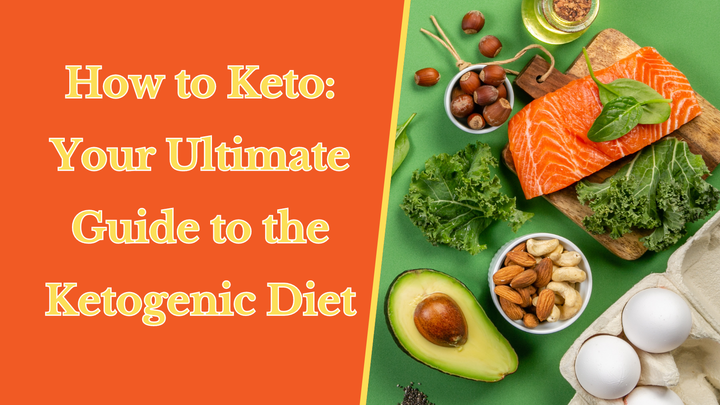How to Reduce Keto Flu Symptoms: A Guide to Easing Your Keto Transition

Embarking on a ketogenic diet can be an exciting journey towards health and weight loss.
However, the initial phase often comes with a set of challenges, commonly known as the keto flu.
This article aims to inspire and guide you through practical steps to reduce keto flu symptoms, ensuring a smoother transition into your new diet.
Key Takeaways:
- Understand the keto flu symptoms and why they occur.
- Learn practical strategies to alleviate these symptoms.
- Discover how to maintain proper nutrition and hydration to minimize discomfort.
Recognizing Keto Flu Symptoms
When you start a ketogenic diet, your body undergoes a significant shift in its main energy source, transitioning from burning glucose to burning fat.
This change can lead to a range of flu-like symptoms as your body adapts to producing ketone bodies. Symptoms typically include fatigue, headaches, brain fog, and muscle cramps.
Recognizing these signs is the first step in managing them effectively.
The Science Behind Keto Flu
The discomfort you experience during the initial stages of a ketogenic diet is often due to carbohydrate withdrawal.
As you drastically reduce your carb intake, your body depletes its stored glucose and begins the process of entering ketosis.
This metabolic state can lead to an electrolyte imbalance and a temporary decline in energy levels as your body adjusts to burning fatty acids for fuel.
Stay Hydrated to Combat Symptoms

One of the simplest yet most effective ways to reduce symptoms of the keto flu is to stay hydrated.
As your body shifts into nutritional ketosis, it sheds excess water, which can lead to dehydration.
Drinking plenty of water, along with beverages that replenish electrolytes, can help mitigate symptoms like headaches and fatigue.
Add More Salt to Your Diet

During the keto induction phase, your body loses more salt than usual.
To counteract this, consider adding more salt to your meals or drinking sports drinks that contain sodium.
This can help maintain your electrolyte balance and reduce symptoms such as dizziness and muscle cramps.
Gradually Reduce Carbohydrate Intake
Instead of drastically cutting carbs overnight, try reducing your carbohydrate intake gradually.
This can help your body ease into the new diet without experiencing severe symptoms.
Start by eliminating processed foods and high-carb snacks, then slowly lower your intake of starchy and sugary foods over several weeks.
Increase Intake of Healthy Fats
Healthy fats are the cornerstone of the ketogenic diet.
By increasing your intake of fatty acids from sources like avocados, nuts, and olive oil, you can help your body transition into fat-burning mode more comfortably.
This can also help reduce cravings and keep you satiated, making it easier to stick to your low carb diet.
Monitor Your Electrolyte Levels
An electrolyte imbalance can cause many keto flu symptoms.
To avoid this, ensure you're getting enough potassium, magnesium, and calcium through your diet.
Leafy greens, nuts, and avocados are excellent sources of these essential minerals.
Supplements can also be beneficial if dietary intake is insufficient.
Light Exercise Can Help
While it's advisable to avoid strenuous exercise during the first week of keto, lighter forms of physical activity like walking or yoga can help alleviate symptoms.
Exercise can boost your mood and energy levels, helping you push through the initial discomfort.
Understanding Ketosis: Your Body's Metabolic Shift
The ketogenic diet is a transformative experience, one that requires your body to make a significant metabolic shift.
As you embark on this journey, it's crucial to understand what's happening within your body. When you reduce your carbohydrate intake, your body begins to search for an alternative fuel source.
This is where the magic of ketosis comes into play. Your liver starts to produce ketone bodies, which become the new energy source, replacing glucose.
This shift can lead to the experience of keto flu symptoms as your body adapts to burning fat for fuel instead of carbohydrates.
Embracing this change can be both challenging and rewarding. As your insulin levels stabilize and your body becomes more efficient at burning fat, you may begin to lose weight and feel more energetic.
However, during the initial stages, you might encounter flu-like symptoms, often referred to as the "carb flu."
This is simply your body's response to the sudden drop in blood sugar and its effort to adjust to producing and utilizing ketones efficiently.
Remember, this is a temporary phase, and with the right strategies, you can minimize discomfort and embrace the benefits of your body's remarkable ability to adapt.
The Role of Diet Quality in Keto Adaptation
When transitioning to a ketogenic diet, the quality of the foods you choose is paramount. It's not just about slashing carbs; it's about selecting the right types of fats and proteins to nourish your body.
Harvard Medical School emphasizes the importance of focusing on heart-healthy fats and avoiding processed foods to maximize the health benefits of a keto diet.
By incorporating a variety of non-starchy vegetables, you ensure a supply of essential vitamins and minerals, which can help alleviate some uncomfortable symptoms associated with the keto flu.

Moreover, it's essential to pay attention to your intake of net carbs (total carbohydrates minus fiber) to maintain a state of ketosis.
This doesn't mean you have to sacrifice flavor or satisfaction. A well-formulated ketogenic diet is rich in foods like avocados, nuts, seeds, and olive oil, which can help you feel full and satisfied while keeping your daily calories from carbs low.
As you navigate through the initial stages of sugar withdrawal and your body's main energy source shifts, remember that the quality of your diet can make a significant difference in how quickly and comfortably you transition into ketosis.
Avoid Caffeine and Alcohol
Caffeine intake and alcohol consumption can exacerbate dehydration and electrolyte imbalance.
Reducing or eliminating these substances during the early stages of your ketogenic diet can help minimize symptoms like headaches and irritability.
Focus on High-Quality Sleep
Lack of sleep can worsen the symptoms of the keto flu.
Aim for 7-9 hours of quality sleep each night to help your body recover and adjust to the changes in your diet.
A consistent sleep schedule and a relaxing bedtime routine can significantly improve your sleep quality.
Include Non-Starchy Vegetables
Non-starchy vegetables are low in carbs but high in fiber and essential nutrients.
Including a variety of leafy greens and other low carb veggies in your diet can help you feel full and provide the vitamins and minerals needed to reduce keto flu symptoms.
Be Patient with Your Body

Remember that your body is adapting to a significant change.
Symptoms tend to subside after about a week as your body becomes more efficient at burning fat for energy.
Be patient and give yourself time to adjust to this new metabolic state.
Listen to Your Body
If you're experiencing symptoms, it's crucial to listen to your body and not push yourself too hard.
If you feel unwell, take a step back and assess whether you need to adjust your diet or hydration levels.
It's essential to prioritize your health and well-being during this transition.
Seek Professional Advice
If you're experiencing severe symptoms or they persist for more than a few weeks, it's wise to consult a healthcare professional.
They can provide personalized advice and ensure that your dietary changes are safe and suitable for your individual health needs.

Summary
The keto flu can be an uncomfortable hurdle at the start of your ketogenic journey.
By understanding the symptoms and their causes, you can take proactive steps to alleviate discomfort.
Staying hydrated, adjusting your salt and electrolyte intake, gradually reducing carbs, and incorporating healthy fats are all effective strategies.
Light exercise, quality sleep, and a diet rich in non-starchy vegetables will also support your body during this transition.
Remember to be patient and listen to your body, and don't hesitate to seek professional advice if needed.
FAQ Section
How long do keto flu symptoms typically last?
Keto flu symptoms usually last about a week, but this can vary from person to person. Some may experience symptoms for a shorter period, while others might feel them for several weeks as their body fully adapts to the ketogenic diet.
Can I prevent keto flu entirely?
While it may not be possible to prevent keto flu symptoms entirely, you can significantly reduce their severity by following the strategies outlined in this article, such as staying hydrated, managing electrolytes, and gradually reducing carb intake.
Is it necessary to add more salt to my diet on keto?
Yes, it's often necessary to increase salt intake on a ketogenic diet, especially during the initial stages, to compensate for the increased sodium loss that occurs when carb intake is reduced and to help maintain electrolyte balance.


